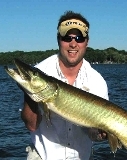|
|

Location: SE Wisconsin | Legends of the Fall
-Color Choices-
By: Sam Ubl
Autumn leaves are never ignored. Their effervescence draws your eye from the beginning of their turnover until the snow covers their grounded reflection. As winter melts away and spring rains fertilize the defrosted ground, only then is the new greenery superlative to the colors of fall. It’s a cornerstone to the refreshing warmth of summer, yet it’s a short-lived refreshment as our eyes grow used to the greenery. Only when the wind shifts and a strong breeze suggests a storm is approaching do we again turn our attention back to the leaves. While still green, they flip to their dull side as if to warn us of the weather to come, and so I got to thinking.
Muskies are predators by nature, yet sometimes by choice. What draws their attention besides the feeling in their lateral line and mandible’s sensory pores? Ultimately, what draws their eye? Water displacement and relative vibration surely excites our quarry, so much so that a blind musky can effectively feed. While the theory that color doesn’t make a difference can be proven at times, it surely can’t be the staple in every scenario.
As musky fishermen, we talk about color all the time; it’s a popular discussion. When to throw natural versus artificial colors seems to be the mainstay for these conversations, and surely they go deeper, such as the idea of natural colors lacking a visual profile, or the concept of the purkinje shift. As a boy my father first introduced me to the turning leaf concept I described at the end of my first paragraph. It’s a theory that has planted a garden of ideas I base a lot of my lure color choices on.
The idea, while not my own, of natural paintjobs of lures imitating a relative forage base and lacking a visual profile is an interesting one. Surely fish are patterned according to their primary niche for camouflaging purposes, theirs little to no question there. Does its relationship to a muskies strike or lack there of go beyond that simple aspect? I believe it does, and once again I’ll refer back to my first paragraph.
Why are juvenile muskies easier to catch? Sure, they may not have fallen victim to barbed hooks yet, but could it be they aren’t yet bored of their prey? In the first couple years of a muskies life, they feed more often and grow rapidly compared to a larger, older fish. To them, life might just be a little more fun as their youth and smaller size allows them more energy to chase down prey. Imagine a hungry energetic child in a candy store and how sticky their fingers could become if you let them touch all the variety that appeals to them. As an adult, I’m assuming you would be less enthused by the spectrum of colors as their appeal may only compromise a severe craving or hunger. Much the same, I believe that a relatively large musky who has lived amongst the perch, suckers, bluegills, etc. may no longer see the excitement they once did in their adolescent years. Furthermore, no longer are they as vulnerable to be caught on just about anything you throw at them like their younger kin.
This theory doesn’t resolute to boredom alone, rather it can spin off another direction. Assuming the boredom theory holds true, much the same as our enthusiasm fades with the constant greenery of summer, suffice it to say that artificial colors can trip the trigger you feel half way back on your cast’s retrieve. Beyond the science of the purkinje shift, where differences in color contrast under different levels of illumination can increase lure visibility, lies a simpler perspective – the significance of change. While almost all musky lures are shaped or assembled to imitate a forage species by movement and profile, perhaps what distinguishes an buyer from a window shopper is the change in color.
By no means am I suggesting that natural colors don’t work, in fact, over two-thirds of my tackle reflect natural paintjobs, blades and skirts. I also utilize the concept of purkinje shifts to the fullest and take head to the idea of natural camouflaging falling victim to a lack of visual profile. I’ll never be one to profess that color doesn’t matter as all is relative to the circumstances. Yes, a blind fish can be caught, but perhaps the next time you set out to catch one of the other 99% of the species you’ll consider more than the “hold your hand up to the sky” theory when deciding what color to use.
Edited by Sam Ubl 5/15/2009 3:24 PM
| |
| |
|
 Legends of the Fall ~ Colors ~ A Musky Article
Legends of the Fall ~ Colors ~ A Musky Article Legends of the Fall ~ Colors ~ A Musky Article
Legends of the Fall ~ Colors ~ A Musky Article